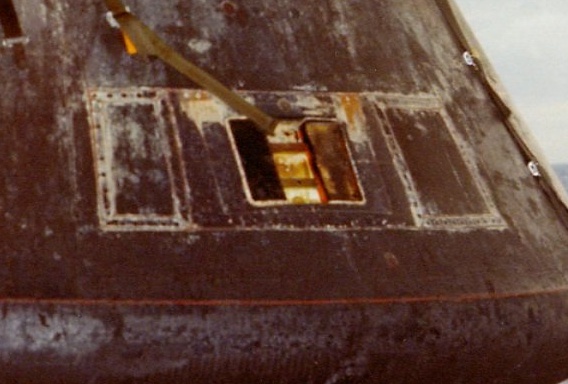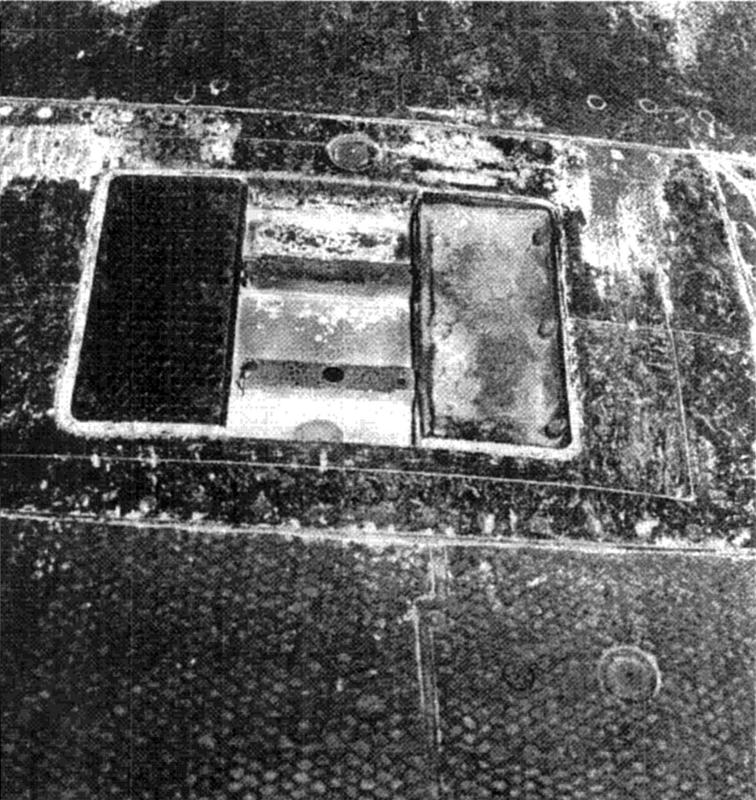Apollo 6 Ablator Test (Umbilical)
One of the experiments performed on Apollo 6 was an investigation into alternate ablator materials. One of the areas containing an ablator panel was the simulated Block II umbilical (the other was one of the side windows).
Page 23 (p. 29 in the PDF) of the Apollo 6 Press Kit [direct link to 4.9 meg PDF] from the heroicrelics mirror of the Kennedy Space Center Library press kit page contains a description of the experiment:
ABLATOR TEST PANELSThree ablator test panels will be flown on the Apollo 6 command module. Two will be in the simulated windward umbilical cavity and the third will replace the meteoroid window cover of the left crew window.
The two patches in the umbilical area are 4 by 9-inch rectangles 1.49 inches thick with an additional .07-inch thick fiber glass backing. One of these patches is the current Apollo Avco honeycomb heat shield material with one-third of the ablator material removed to represent a possible weight saving technique. The second patch is a low density, modified polyurethane foam developed by NASA's Ames Research Center. It is being studied as a possible heatshield material for future spacecraft.
The polyurethane foam material has a density of 2.2 pounds per cubic foot, compared to 33 pounds per cubic foot for the present honeycomb heat shield material.
The test panel over the window is a trapezoid 12.32 inches high, 13.1 inches wide at the base and 10.6 inches at the top. It is divided into three vertical sections. The left section contains the honeycomb material with one-third of the ablator removed. The middle section is end grain balsa wood. The right section is the modified polyurethane foam. All three sections are 0.7 inches thick.
Balsa is the natural material of lowest density with reasonable ablation properties. It is being compared with other materials in a flight test.
Here's a description of the results of the ablator experiment from the Apollo 6 Mission Report (alternate link), p. 5.4-5 and 5.4-6 (p. 135-136 in the PDF):
Low-density ablator experiment.- A low-density ablator experiment, developed for flight evaluation on the Apollo 6 mission, was successfully recovered intact. The three low-density materials selected for the experiment were urethane foam 5I, which has a density of 2.2 lb/ft3; balsa wood, which has a density of 8.3 lb/ft3; and the Apollo ablator, which, because of the 5/16-in.-diameter holes drilled through three-fourths of the local ablator thickness in each honeycomb cell, had an effective density of 20 lb/ft3.
The flight hardware consisted of three panels. The postflight appearance of the panel in the leeward micrometeoroid window location (which contained samples of the three ablation materials) is shown in figure 5.4-14(a). The postflight conditions of the urethane foam panel and the Apollo ablator panel in the simulated umbilical region are shown in figure 5.4-14(b).
Postflight inspection of the window panel showed that entry heating had very little effect on the materials. A slight swelling of approximately 0.10 inch on the foam material was observed; the balsa wood and Apollo ablator with holes showed no significant thermal effects.
Recession of the Apollo ablator panel in the umbilical area varied from 0.030 to 0.040 inch and the char penetration varied from 0.15 to 0.20 inch. The urethane foam panel from this area had approximately 0.45 to 0.50 inch of virgin material remaining; the entire char layer was missing from the urethane foam panel, probably as a result of landing impact or wave action prior to recovery; the loss can be attributed to the weakness and fragility of the char formed during heating. Temp-plate temperature indicators (which change color at designated temperatures) attached to the stainless steel backup plate of each test panel indicated that the backface temperature did not exceed 200° F.
In summary, satisfactory thermal performance of all materials used in the experiment was demonstrated. However, the usefulness of the urethane foam material in the present form is considered to be limited because of the fragility and poor structural integrity of the material.
Here is figure 5.4-14(b), showing the ablative panels in Apollo 6's simulated Block II umbilical. Note that the two rows of wires (simulated wires?) have been shortened to make room for the ablator panels; compare to the simulated Block II umbilical on Apollo 4 or an actual Block II umbilical on Apollo 14.
Click image for a 1210x1374 pixel version of this image in a new window.
From p. 5.4-44 (p. 174 in the PDF) of Apollo 6 Mission
Report (alternate
link)
Extraction and cleanup by heroicrelics.
The scan quality of the Mission Report is rather poor, and I can't find S-68-3691 anywhere else on the Internet. If you know where I can obtain a better picture, please contact me.
Here's a picture of the ablator panels taken on the recovery ship:

A full-size crop from S68-27041

